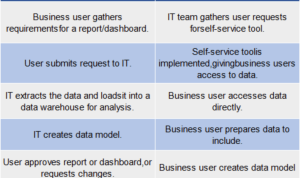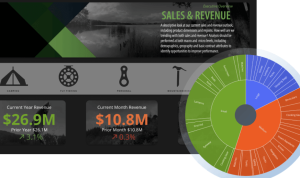BI in Action: Improving Employee Retention with Data Insights sets the stage for this enthralling narrative, offering readers a glimpse into a story that is rich in detail and brimming with originality from the outset. In today’s competitive job market, employee retention has become a crucial focus for organizations aiming to maintain a stable and engaged workforce. By harnessing data insights through Business Intelligence (BI) tools, companies can identify trends, pinpoint areas of concern, and implement effective strategies to foster a positive work environment that keeps employees motivated and loyal.

In the ever-evolving landscape of technology, one cannot help but marvel at the rapid advancements that have shaped our daily lives. From the way we communicate to how we work and entertain ourselves, technology has revolutionized our world in numerous ways. This article aims to delve into several key areas where technology has made a significant impact, offering insights into both the benefits and challenges it presents.### CommunicationOne of the most profound changes brought about by technology is in the realm of communication.
Gone are the days when sending a letter took days or even weeks; now, we can connect with someone across the globe in mere seconds. With the advent of smartphones and social media platforms, we are constantly in touch with friends, family, and colleagues. Apps like WhatsApp, Facebook, and Twitter have transformed the way we interact, allowing us to share our thoughts, experiences, and emotions instantaneously.However, this ease of communication also comes with its own set of challenges.
The rise of digital communication has led to a decline in face-to-face interactions, which can affect our social skills and emotional connections. Additionally, with the increased use of social media, issues such as cyberbullying and misinformation have become prevalent, making it essential for individuals to navigate this digital landscape with caution.### Work EnvironmentThe workplace has seen a dramatic transformation due to technology.
Remote work has gained immense popularity, especially in light of recent global events. Tools like Zoom, Slack, and Trello have enabled teams to collaborate effectively from various locations. This shift has not only increased flexibility for employees but has also allowed companies to tap into a global talent pool.Yet, while remote work offers numerous advantages, it also poses challenges. The boundaries between work and personal life can blur, leading to burnout.
Moreover, some individuals may find it difficult to maintain productivity without the structure of a traditional office environment. Companies must now focus on creating a supportive remote work culture that prioritizes employee well-being and engagement.### EducationTechnology’s influence on education is undeniable. With online learning platforms and digital resources, education has become more accessible than ever before. Students can now access a wealth of information at their fingertips, making it easier to explore topics of interest and enhance their learning experiences.
Online courses and virtual classrooms have provided opportunities for individuals who may not have had access to traditional educational settings.However, the digital divide remains a significant concern. Not all students have equal access to technology or the internet, which can hinder their ability to learn effectively. Moreover, the effectiveness of online learning is often debated, as some students thrive in traditional classroom settings while others may struggle with the lack of in-person interaction.
Educators must strive to create inclusive learning environments that cater to diverse learning styles and needs.### EntertainmentThe entertainment industry has also undergone a massive transformation thanks to technology. Streaming services like Netflix, Hulu, and Spotify have changed the way we consume media. We can now enjoy movies, TV shows, and music on-demand, tailoring our entertainment experiences to our preferences. This shift has given rise to new forms of content creation, with independent filmmakers and musicians finding platforms to showcase their work.Nevertheless, the abundance of content can lead to decision fatigue for consumers.
With so many options, it can be challenging to choose what to watch or listen to. Additionally, the rise of streaming has led to concerns about the impact on traditional media, such as cinema and live performances, prompting discussions about the future of these industries.### Health and WellnessTechnology has also made significant strides in the health and wellness sector. From wearable fitness trackers to telemedicine, individuals now have more tools at their disposal to monitor and manage their health.
Apps that track physical activity, nutrition, and mental health have empowered users to take control of their well-being in ways that were previously unimaginable.However, the reliance on technology in health care raises questions about data privacy and security. Patients must trust that their personal information is protected while using digital health services. Additionally, the proliferation of health-related apps can make it difficult for individuals to discern between credible sources and unverified information, underscoring the importance of critical thinking in the digital age.### Future TrendsAs we look to the future, it is clear that technology will continue to shape our lives in profound ways.
Emerging technologies like artificial intelligence, virtual reality, and blockchain are poised to revolutionize various sectors, from finance to transportation. These advancements hold the potential to improve efficiency, enhance security, and create new opportunities for innovation.However, with these advancements come ethical considerations and challenges. As AI continues to evolve, questions about job displacement, privacy, and bias in algorithms must be addressed.
Society must work together to ensure that technology serves the greater good and benefits everyone, rather than exacerbating existing inequalities.In conclusion, technology has undeniably transformed our world, influencing communication, work, education, entertainment, and health. While it offers numerous benefits, we must remain vigilant about the challenges it presents. By fostering a thoughtful and responsible approach to technology, we can harness its power to create a better future for all.
As we embrace the possibilities that lie ahead, it is essential to strike a balance between innovation and ethical responsibility, ensuring that technology remains a force for good in our lives.







